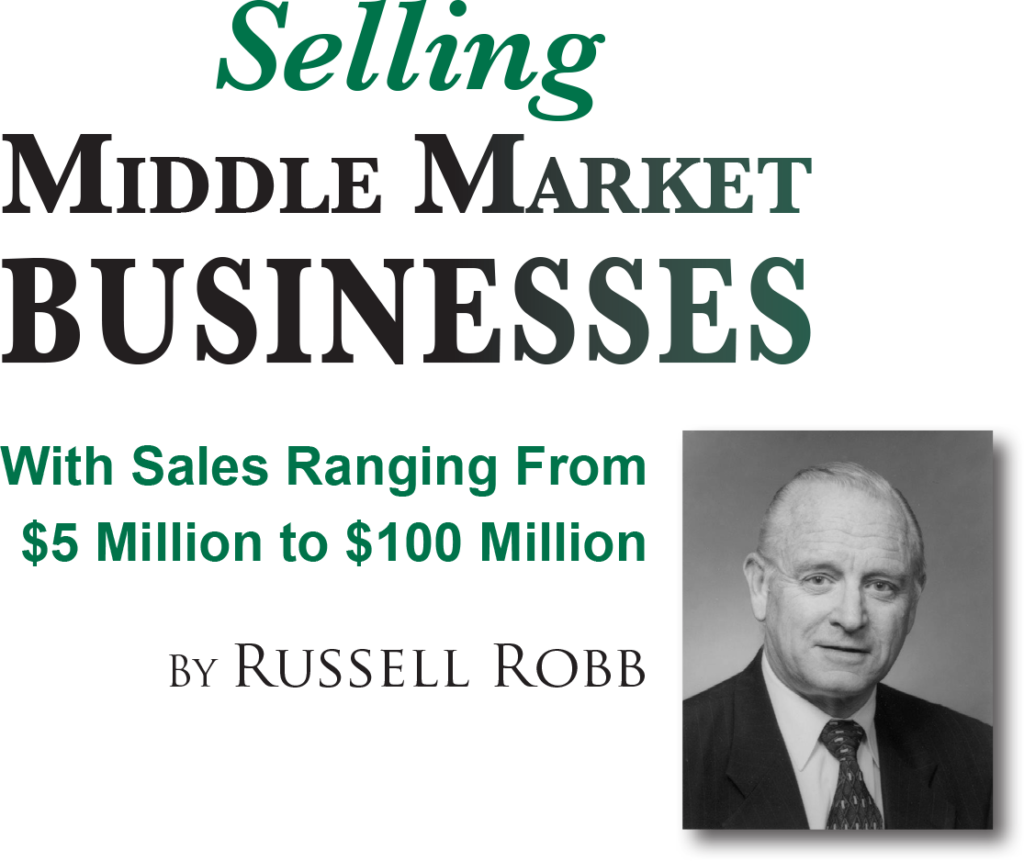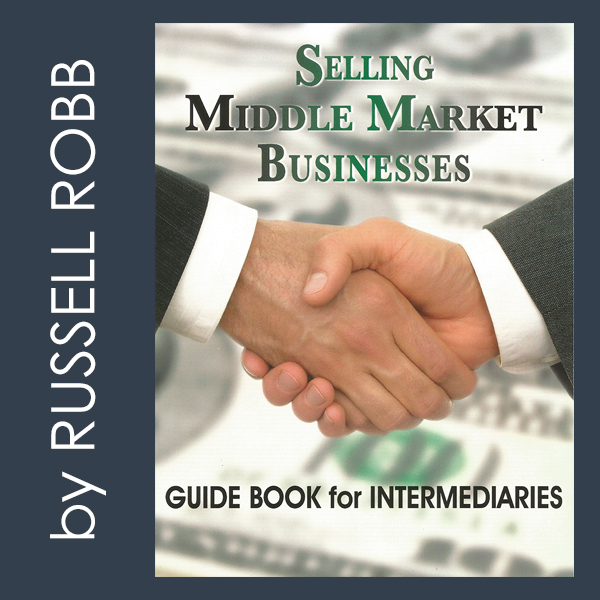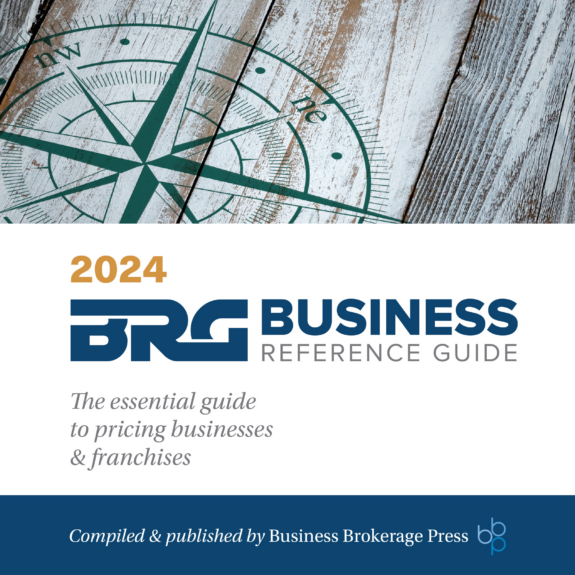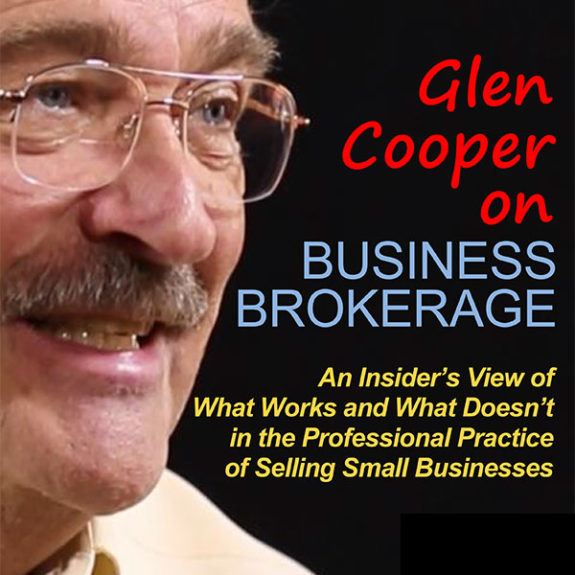Shop
Selling Middle Market Businesses: Guide Book for Intermediaries
$160.00

After 14 years of writing a national newsletter, M&A TODAY, published by Business Brokerage Press, Russ Robb has published a 400+ page book that in one volume captures the entire process of selling middle market businesses (With Sales Ranging From $5 Million to $100 Million) from the intermediary’s point of view. The book contains examples of the proposal letter, the confidentiality agreement, the fee agreement, the term sheet, the letter of intent, the purchase & sale agreement, etc.
REASON FOR GOING UPMARKET
A national progression of growing one’s brokerage business by selling companies to companies instead of selling companies to individuals. Going upmarket is more profitable for you the intermediary, more selective in contacting buyers, but conversely it takes more knowledge by the intermediary… hence the necessity of this book.
REASON COMPANIES ARE FOR SALE
The short answer is “death, divorce and despair.” The all encompassing short answer is the following:
- Burnout
- Profit Motive
- Boredom
- Lack of Growth Capital
- Competition
- Ownership Issues
- Age/Health
- Technology Restraints
Chapters
Chapters
- Why People Sell Their Businesses
- The Seller’s Disadvantage
- The Common Myths In Selling
- Prior To Sale, Run Your Business Differently
- Important Points in Selling A Business
- Targeting The Buyer
- Preparing A Selling Memorandum
- When To Sell
- Key Steps In Selling A Business
- More Steps For A Successful Sale
- Understanding Cultured Fit
- Seller’s Dilemmas & Mistakes
- Intermediaries
- Your Team Of Advisors
- Selling Troubled Companies
- Valuation Techniques
- Value Drivers
- Goodwill
- Negotiating
- Putting The Deal Together
- Understanding Buyer’s Concerns
- Letter Of Intent
- Presentation Of Warranties
- Deal Breakers
- Management Buyouts
- ESOPs
- Leverage Re-Cass
- Selling Parts Of A Company
- Legal And Tax Issues
- Expediating Change Of Control
- Red Flags Surprises Prior To Closing
- The Closing
- Post Mortem
- Pearls Of Wisdom
- Case Studies
- Conclusion
- * Proposal Letter
- * Confidential Agreement
- * Fee Agreement With Intermediaries
- * Term Sheet
- * Letter Of Intent
- * Purchase Agreement
- * Glossary
Valuation Considerations
Valuation Considerations
Having worked for a valuation firm in the past, I was dismayed to view the appraisal mostly based on the objective financial numbers without consideration for proprietary products or services, market share, customer concentration, cyclical or seasonality, management depth, financial systems, value drivers, outdated machinery and equipment (M&E), supporting sales growth, etc.
Naturally, most sellers want all cash at closing, but it is estimated that only one-third of middle market transactions are structured that way. In many deals, the structure is more important than the price, so if a seller is inflexible on structure, it can be a major obstacle and most likely a deal breaker.
Another way to analyze whether to be flexible with the structure of the transaction is to look at the alternatives. Suppose the owner were to receive offers by the same buyer as follows, which should he accept?
$5.0 million for the acquirer’s stock
$4.5 million (half in earnout; half in unsecured notes)
$4.0 million (half in cash; half non compete
obligations)
$3.5 million (all cash but hefty escrow accounts
and tight representations and warranties)
$3.0 million (all cash, no escrow accounts, no
representations and warranties, and deal close
in 60 days).
As a seller, the seller will be faced with a decision on a risk/reward basis: the higher the risk, the higher the reward. There is no correct answer; it depends on the individual seller. A seller could charge the buyer proportionally more for the C corporation if it is an asset sale by the seller keeping the liabilities. The buyer usually will want to acquire the company’s assets, not its stock, in order to avoid prior liabilities and to be able to mark up the assets to fair market value for depreciation purposes
Typical Knowledge Imparted from Book...Red Flags
Typical Knowledge Imparted from Book...Red Flags
It is sadly ironic that while buyers often conduct extensive due diligence on the seller, seldom does the seller conduct thorough due diligence on the buyer. Many deals are aborted along the way, yet there are red flags that the seller should notice with the buyer and use to reevaluate whether or not to go forward with the transaction.
Red Flags for Sellers
- Inability of buyer to prove to seller that the buyer has the capacity financially to do a desired deal which is mostly in cash at closing.
- A sense that the buyer and/or his advisors are inexperienced in consummating a transaction.
- Unreasonable representation and warranties and escrow accounts to be held from closing settlement.
- Too broad a Letter of Interest to qualify for the management meeting, and too vague for the Letter of Intent.
- Unexpected low bid.
- By reputation, especially private equity groups, if there is a slight hiccup in the selling company’s operation, the buyer will re-price the deal.
Red Flags for Buyers
- General lawyer vs. M&A transaction attorney for seller.
- Lack of confirmation of parameters of deal by seller’s Board of Directors, majority shareholder, seller’s bank and/or team of advisors including the seller’s intermediary.
- Deals that drag tend not to close.
- Delay or unusual slowness in sharing financial or confidential information.
- At the management meeting stage, the resistance of involving several key managers, namely the CFO and Sales Manager
Pearls of Wisdom
Pearls of Wisdom
- Set timeframes on the selling process in order to have milestones: 1) complete selling memorandum; 2) contact buyers; 3) negotiate best offer; 4) sign Letter of Intent; 5) allow two months for buyers’ due diligence; 6) close the deal. Deals that drag don’t close.
- Set up a complete file in one place (war room) of all relevant information the buyer or his due diligence team will ultimately request: contracts, distribution and purchase agreements, leases, licenses, and intellectual property documents.
- What is most damaging for a seller is coming across as a one-man band without qualified supporting staff.
- Hire a great transaction lawyer because the buyer will probably have the best available attorney. Keep the momentum going. Deals that drag don’t close. Energy and zeal are critically important.
- Once a seller signs a Letter of Intent, even though it is largely non binding, his leverage drops dramatically. Therefore, before signing, make sure it covers as many critical deal points as possible and the “no shop” provision is as a short a time period as practical.
- One of the critical aspects of an intermediaries’ business philosophy is to be very selective in taking on assignments especially if the firm is familiar with the potential client’s industry sector.
- The most important part of an intermediary’s commission, regardless of the size of the deal is to negotiate a “minimum fee” of the percentage of the transaction price which prevents potential loopholes implemented by the other party






















